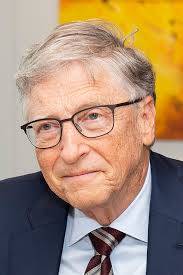Bill Gates is an American business magnate, software developer, investor, and philanthropist, best known as the co-founder of Microsoft Corporation, which became the world’s largest personal-computer software company. Gates is also widely recognized for his extensive philanthropic work through the Bill & Melinda Gates Foundation. For several years, he was the richest person in the world, and he remains one of the most influential figures in technology and philanthropy.
Early Life and Education:
William Henry Gates III was born on October 28, 1955, in Seattle, Washington, to William H. Gates Sr., a prominent lawyer, and Mary Maxwell Gates, a businesswoman and community leader. He grew up in an upper-middle-class family with two sisters, Kristianne and Libby.
From a young age, Gates displayed an interest in computing and mathematics. He attended the exclusive Lakeside School, where he was first introduced to computers. It was at Lakeside that Gates met Paul Allen, who would later become his business partner. Gates and Allen bonded over their love of computers and began programming together. At the age of 13, Gates wrote his first software program: a tic-tac-toe game that allowed users to play against the computer.
After graduating from Lakeside, Gates enrolled at Harvard University in 1973, initially pursuing a degree in law, but he spent much of his time in the university’s computer lab. In 1975, at the age of 20, Gates dropped out of Harvard to pursue his passion for software development, forming a company with Paul Allen.
Founding Microsoft (1975):
In 1975, Gates and Allen co-founded Microsoft (originally called Micro-Soft, short for “microprocessors†and “softwareâ€) with the vision of putting a computer on every desk and in every home. Their first major success came when they adapted BASIC, a programming language, for the Altair 8800, one of the earliest personal computers.
In 1980, Microsoft signed a pivotal deal with IBM to provide the operating system for their personal computers. Gates purchased an existing operating system called QDOS from another company, modified it, and renamed it MS-DOS (Microsoft Disk Operating System). MS-DOS became the standard operating system for IBM-compatible PCs, and this deal established Microsoft as a major player in the software industry.
Windows and Microsoft’s Dominance:
In 1985, Microsoft launched its first version of Windows, a graphical operating system that offered a user-friendly interface on top of MS-DOS. Windows was a major step forward in making computers accessible to a broader audience. The subsequent release of Windows 3.0 in 1990 and Windows 95 in 1995 cemented Microsoft’s dominance in the personal computing market. By the mid-1990s, Microsoft controlled the operating systems of over 90% of the world’s personal computers.
Gates became known for his intense and competitive leadership style, focusing on innovation and strategic business moves. Under his guidance, Microsoft diversified its product offerings, expanding into office productivity software with Microsoft Office and later into areas like web browsers, video games (with Xbox), and cloud computing.
Antitrust Lawsuits and Leadership Transition:
As Microsoft grew, it faced legal challenges. In the late 1990s, the U.S. Department of Justice and several states filed antitrust lawsuits against Microsoft, accusing the company of anti-


